A Comparative Study of Spanish and English Phonetics and Syntax
VerifiedAdded on 2022/10/14
|7
|1097
|12
Report
AI Summary
This report delves into the linguistic difficulties encountered by English speakers when learning Spanish, focusing on phonetics, phonology, grammatical differences, and syntax. The study originates from personal experiences and observations, highlighting the challenges English speakers face. It compares the phonetics of Spanish and English, noting the five vowels in Spanish versus the varying vowel sounds in English dialects, which contributes to spelling and pronunciation problems. The report explains how the Germanic origin of English and the Latin origin of Spanish further complicates language acquisition. It also explores the grammatical differences, such as sentence structure and the absence of inverted commas in Spanish. The research includes interview questions and responses to illustrate the challenges and differences. The study concludes by summarizing the key aspects that impact English speakers' ability to learn Spanish and suggests that understanding these differences is crucial for effective language learning.
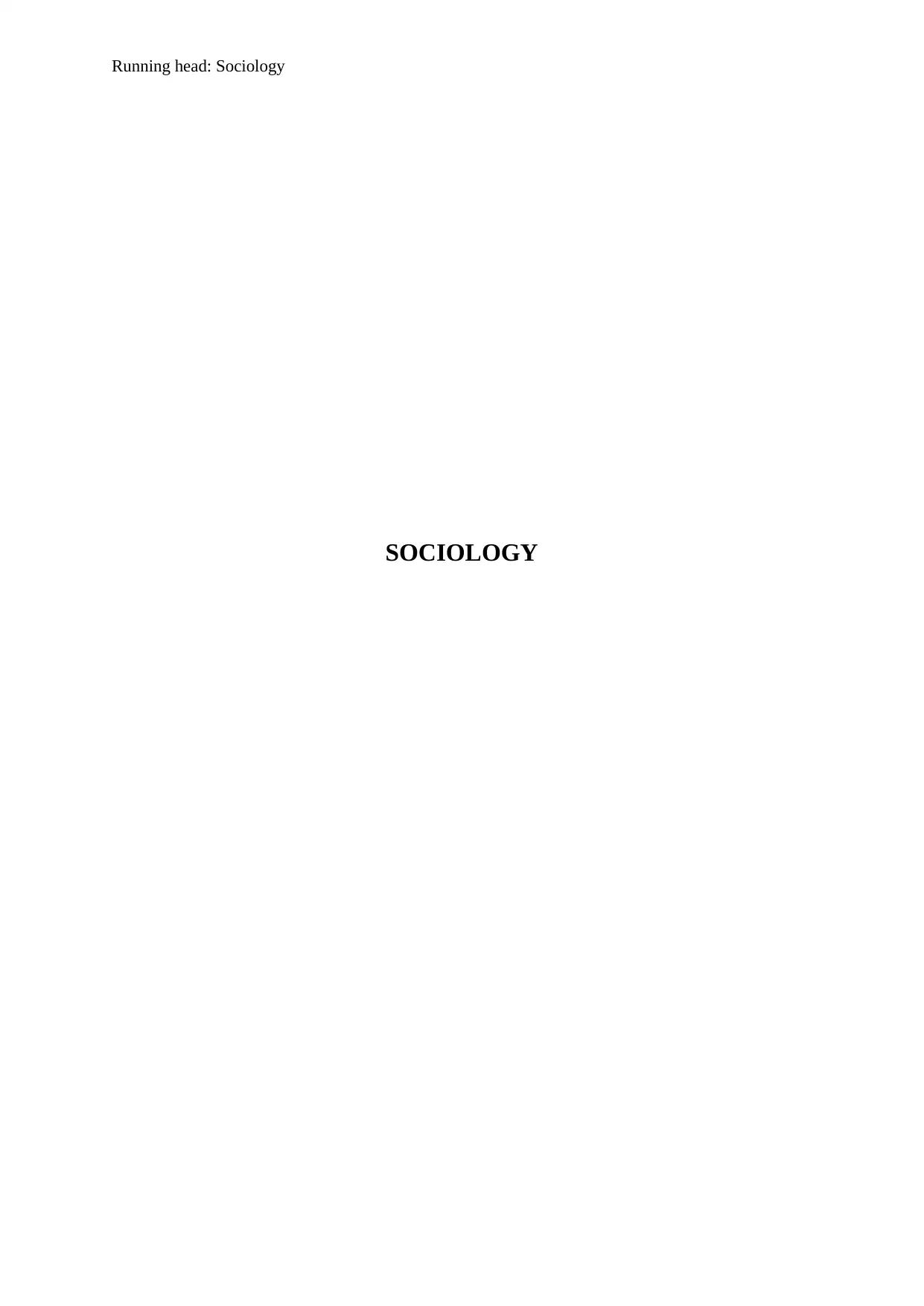
Running head: Sociology
SOCIOLOGY
SOCIOLOGY
Paraphrase This Document
Need a fresh take? Get an instant paraphrase of this document with our AI Paraphraser
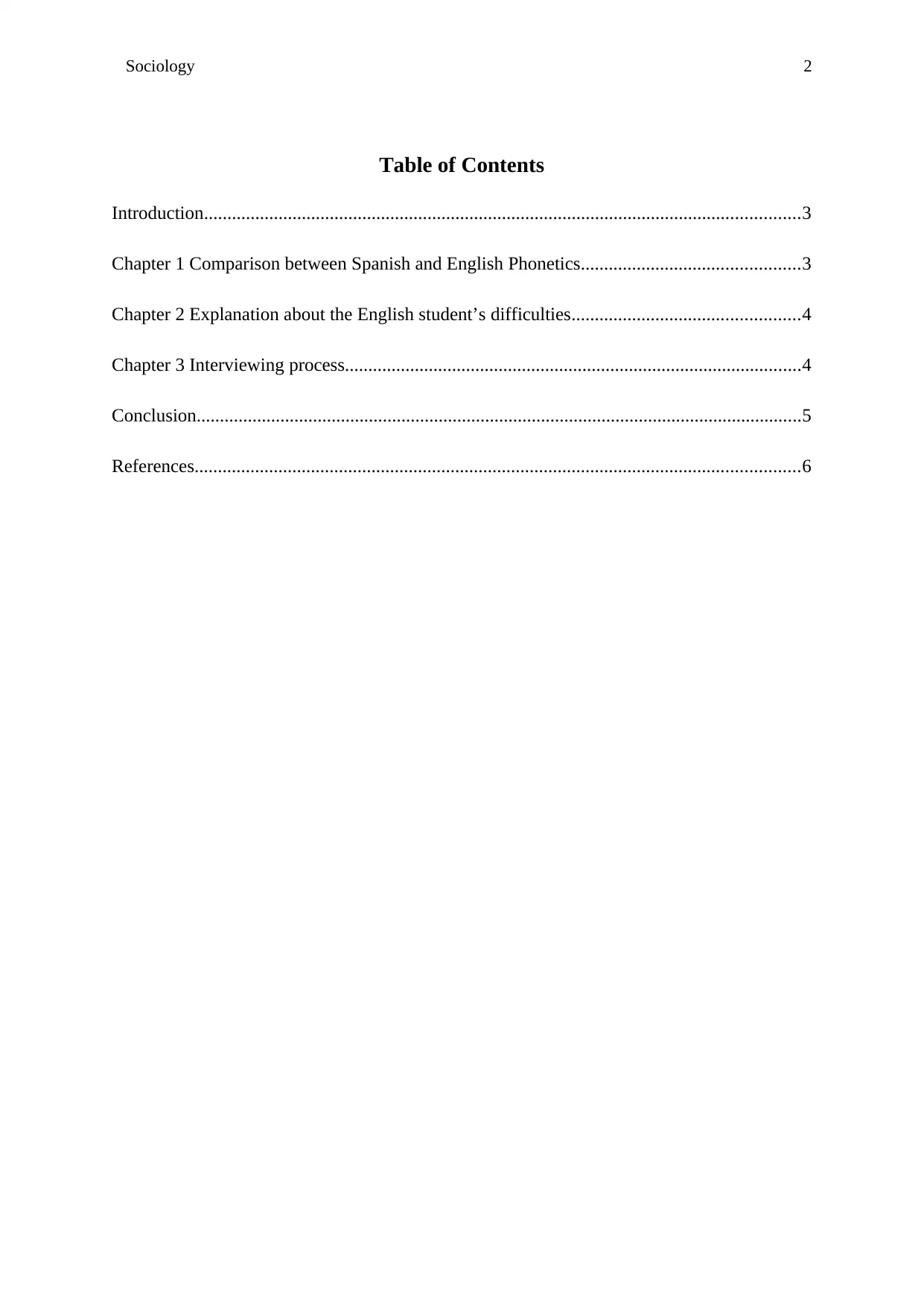
Sociology 2
Table of Contents
Introduction................................................................................................................................3
Chapter 1 Comparison between Spanish and English Phonetics...............................................3
Chapter 2 Explanation about the English student’s difficulties.................................................4
Chapter 3 Interviewing process..................................................................................................4
Conclusion..................................................................................................................................5
References..................................................................................................................................6
Table of Contents
Introduction................................................................................................................................3
Chapter 1 Comparison between Spanish and English Phonetics...............................................3
Chapter 2 Explanation about the English student’s difficulties.................................................4
Chapter 3 Interviewing process..................................................................................................4
Conclusion..................................................................................................................................5
References..................................................................................................................................6
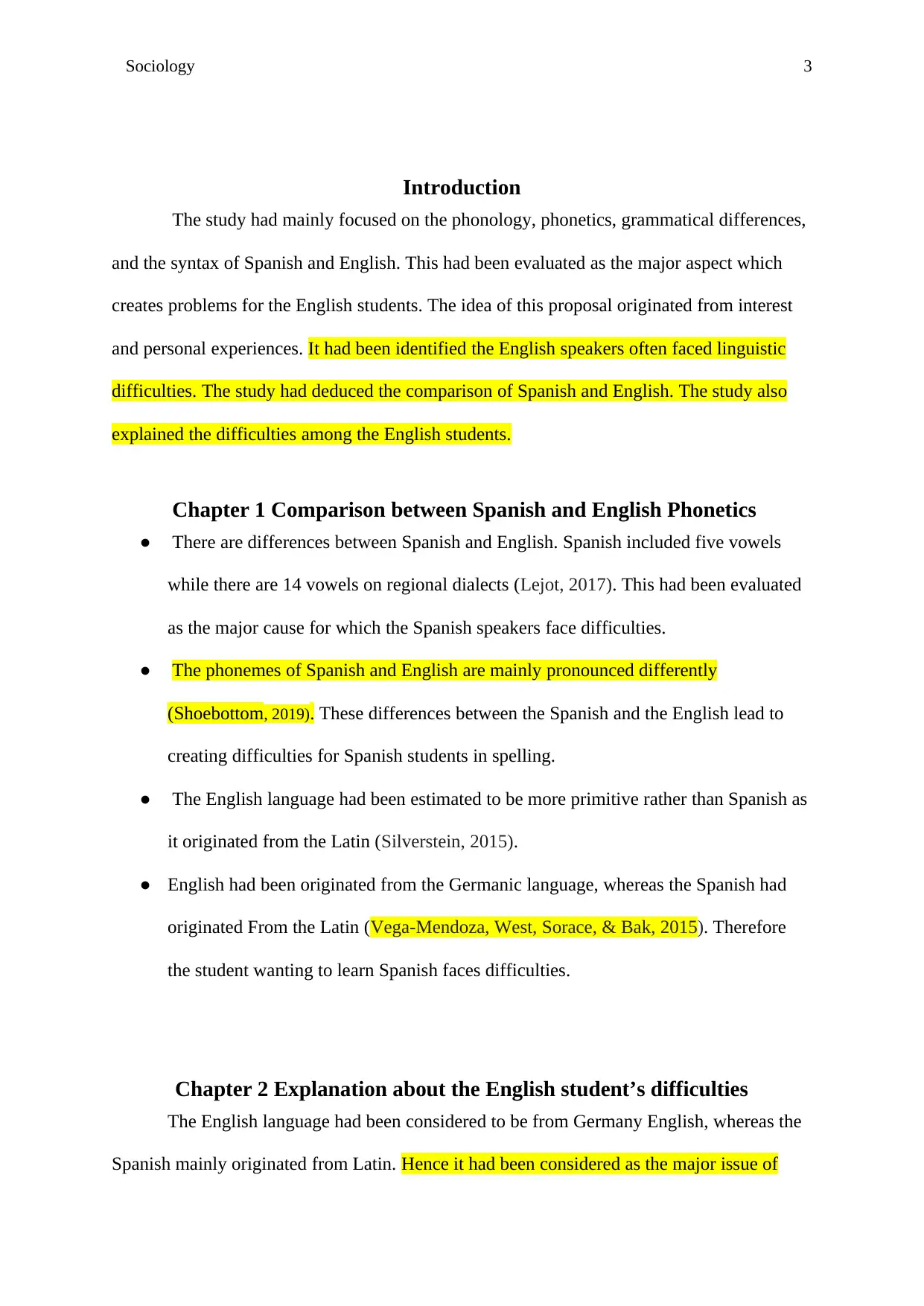
Sociology 3
Introduction
The study had mainly focused on the phonology, phonetics, grammatical differences,
and the syntax of Spanish and English. This had been evaluated as the major aspect which
creates problems for the English students. The idea of this proposal originated from interest
and personal experiences. It had been identified the English speakers often faced linguistic
difficulties. The study had deduced the comparison of Spanish and English. The study also
explained the difficulties among the English students.
Chapter 1 Comparison between Spanish and English Phonetics
● There are differences between Spanish and English. Spanish included five vowels
while there are 14 vowels on regional dialects (Lejot, 2017). This had been evaluated
as the major cause for which the Spanish speakers face difficulties.
● The phonemes of Spanish and English are mainly pronounced differently
(Shoebottom, 2019). These differences between the Spanish and the English lead to
creating difficulties for Spanish students in spelling.
● The English language had been estimated to be more primitive rather than Spanish as
it originated from the Latin (Silverstein, 2015).
● English had been originated from the Germanic language, whereas the Spanish had
originated From the Latin (Vega-Mendoza, West, Sorace, & Bak, 2015). Therefore
the student wanting to learn Spanish faces difficulties.
Chapter 2 Explanation about the English student’s difficulties
The English language had been considered to be from Germany English, whereas the
Spanish mainly originated from Latin. Hence it had been considered as the major issue of
Introduction
The study had mainly focused on the phonology, phonetics, grammatical differences,
and the syntax of Spanish and English. This had been evaluated as the major aspect which
creates problems for the English students. The idea of this proposal originated from interest
and personal experiences. It had been identified the English speakers often faced linguistic
difficulties. The study had deduced the comparison of Spanish and English. The study also
explained the difficulties among the English students.
Chapter 1 Comparison between Spanish and English Phonetics
● There are differences between Spanish and English. Spanish included five vowels
while there are 14 vowels on regional dialects (Lejot, 2017). This had been evaluated
as the major cause for which the Spanish speakers face difficulties.
● The phonemes of Spanish and English are mainly pronounced differently
(Shoebottom, 2019). These differences between the Spanish and the English lead to
creating difficulties for Spanish students in spelling.
● The English language had been estimated to be more primitive rather than Spanish as
it originated from the Latin (Silverstein, 2015).
● English had been originated from the Germanic language, whereas the Spanish had
originated From the Latin (Vega-Mendoza, West, Sorace, & Bak, 2015). Therefore
the student wanting to learn Spanish faces difficulties.
Chapter 2 Explanation about the English student’s difficulties
The English language had been considered to be from Germany English, whereas the
Spanish mainly originated from Latin. Hence it had been considered as the major issue of
⊘ This is a preview!⊘
Do you want full access?
Subscribe today to unlock all pages.

Trusted by 1+ million students worldwide
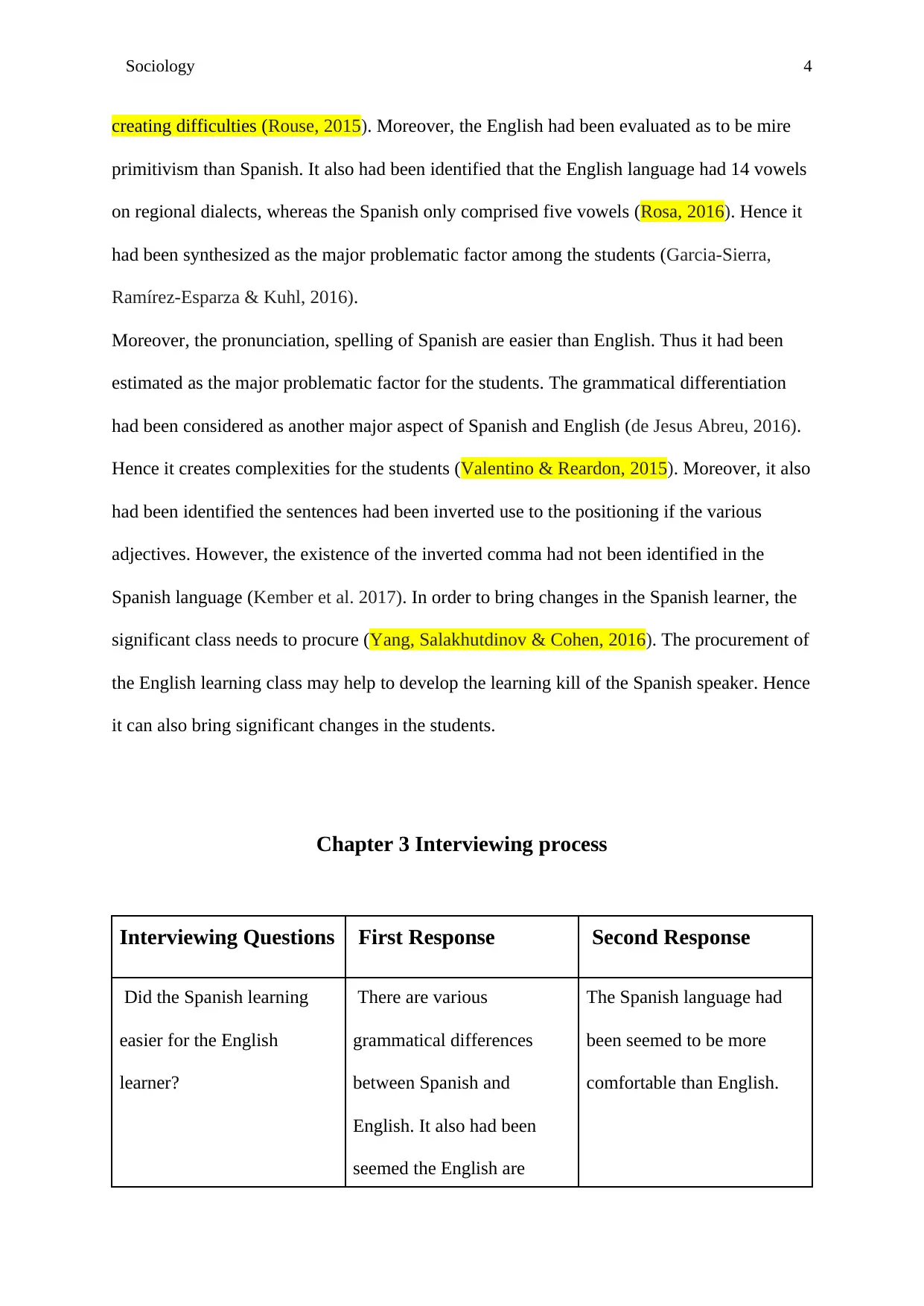
Sociology 4
creating difficulties (Rouse, 2015). Moreover, the English had been evaluated as to be mire
primitivism than Spanish. It also had been identified that the English language had 14 vowels
on regional dialects, whereas the Spanish only comprised five vowels (Rosa, 2016). Hence it
had been synthesized as the major problematic factor among the students (Garcia-Sierra,
Ramírez-Esparza & Kuhl, 2016).
Moreover, the pronunciation, spelling of Spanish are easier than English. Thus it had been
estimated as the major problematic factor for the students. The grammatical differentiation
had been considered as another major aspect of Spanish and English (de Jesus Abreu, 2016).
Hence it creates complexities for the students (Valentino & Reardon, 2015). Moreover, it also
had been identified the sentences had been inverted use to the positioning if the various
adjectives. However, the existence of the inverted comma had not been identified in the
Spanish language (Kember et al. 2017). In order to bring changes in the Spanish learner, the
significant class needs to procure (Yang, Salakhutdinov & Cohen, 2016). The procurement of
the English learning class may help to develop the learning kill of the Spanish speaker. Hence
it can also bring significant changes in the students.
Chapter 3 Interviewing process
Interviewing Questions First Response Second Response
Did the Spanish learning
easier for the English
learner?
There are various
grammatical differences
between Spanish and
English. It also had been
seemed the English are
The Spanish language had
been seemed to be more
comfortable than English.
creating difficulties (Rouse, 2015). Moreover, the English had been evaluated as to be mire
primitivism than Spanish. It also had been identified that the English language had 14 vowels
on regional dialects, whereas the Spanish only comprised five vowels (Rosa, 2016). Hence it
had been synthesized as the major problematic factor among the students (Garcia-Sierra,
Ramírez-Esparza & Kuhl, 2016).
Moreover, the pronunciation, spelling of Spanish are easier than English. Thus it had been
estimated as the major problematic factor for the students. The grammatical differentiation
had been considered as another major aspect of Spanish and English (de Jesus Abreu, 2016).
Hence it creates complexities for the students (Valentino & Reardon, 2015). Moreover, it also
had been identified the sentences had been inverted use to the positioning if the various
adjectives. However, the existence of the inverted comma had not been identified in the
Spanish language (Kember et al. 2017). In order to bring changes in the Spanish learner, the
significant class needs to procure (Yang, Salakhutdinov & Cohen, 2016). The procurement of
the English learning class may help to develop the learning kill of the Spanish speaker. Hence
it can also bring significant changes in the students.
Chapter 3 Interviewing process
Interviewing Questions First Response Second Response
Did the Spanish learning
easier for the English
learner?
There are various
grammatical differences
between Spanish and
English. It also had been
seemed the English are
The Spanish language had
been seemed to be more
comfortable than English.
Paraphrase This Document
Need a fresh take? Get an instant paraphrase of this document with our AI Paraphraser
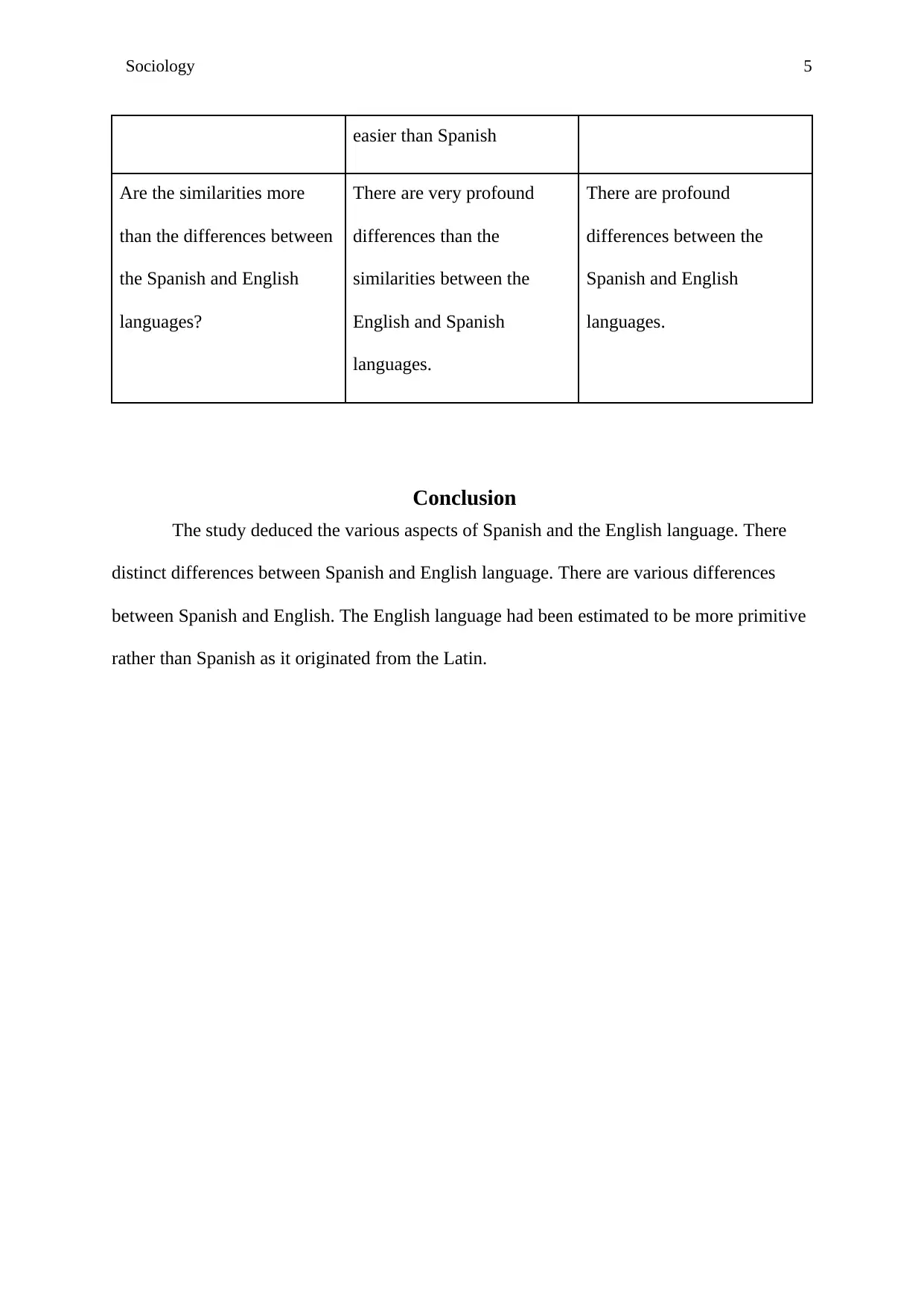
Sociology 5
easier than Spanish
Are the similarities more
than the differences between
the Spanish and English
languages?
There are very profound
differences than the
similarities between the
English and Spanish
languages.
There are profound
differences between the
Spanish and English
languages.
Conclusion
The study deduced the various aspects of Spanish and the English language. There
distinct differences between Spanish and English language. There are various differences
between Spanish and English. The English language had been estimated to be more primitive
rather than Spanish as it originated from the Latin.
easier than Spanish
Are the similarities more
than the differences between
the Spanish and English
languages?
There are very profound
differences than the
similarities between the
English and Spanish
languages.
There are profound
differences between the
Spanish and English
languages.
Conclusion
The study deduced the various aspects of Spanish and the English language. There
distinct differences between Spanish and English language. There are various differences
between Spanish and English. The English language had been estimated to be more primitive
rather than Spanish as it originated from the Latin.
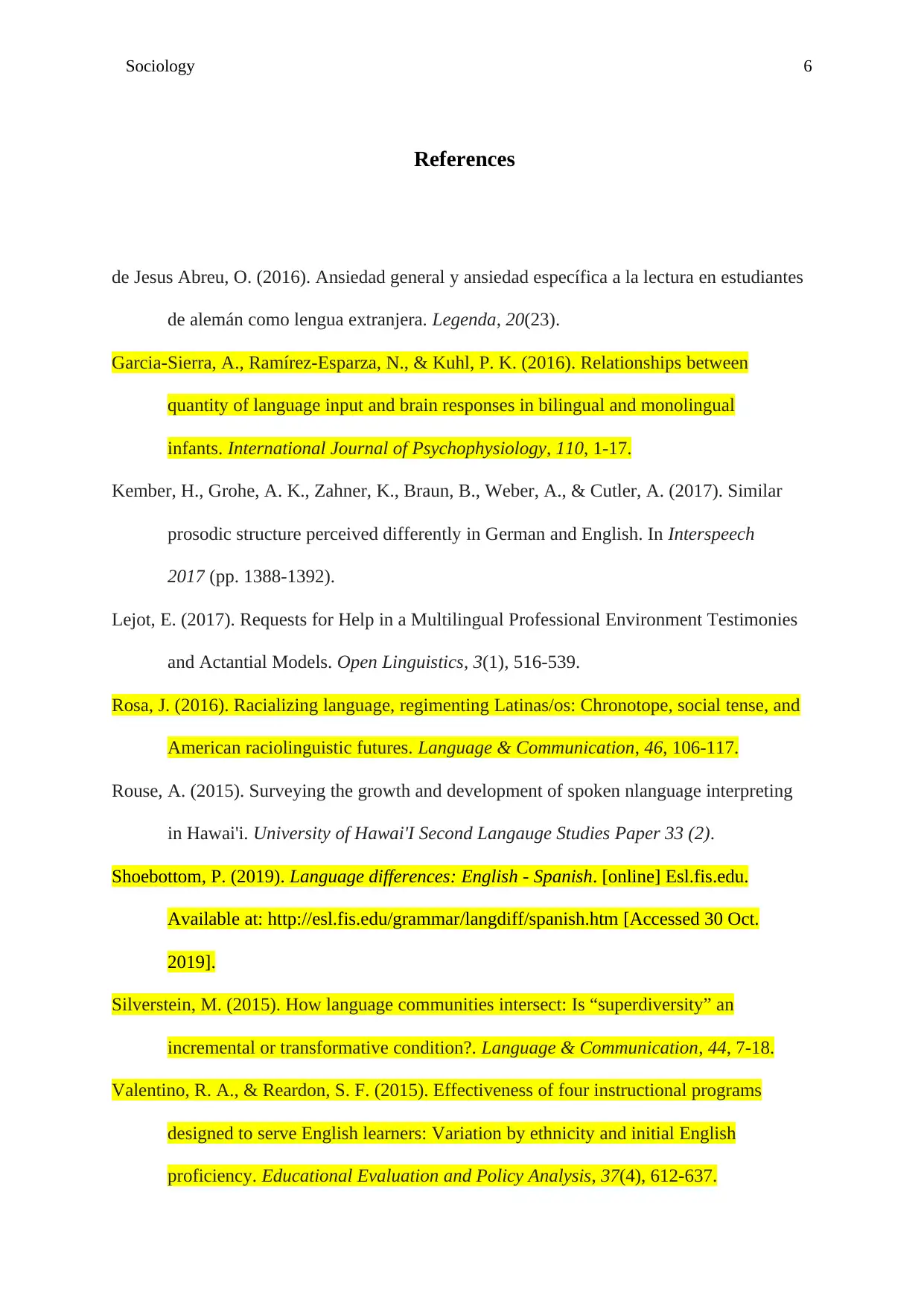
Sociology 6
References
de Jesus Abreu, O. (2016). Ansiedad general y ansiedad específica a la lectura en estudiantes
de alemán como lengua extranjera. Legenda, 20(23).
Garcia-Sierra, A., Ramírez-Esparza, N., & Kuhl, P. K. (2016). Relationships between
quantity of language input and brain responses in bilingual and monolingual
infants. International Journal of Psychophysiology, 110, 1-17.
Kember, H., Grohe, A. K., Zahner, K., Braun, B., Weber, A., & Cutler, A. (2017). Similar
prosodic structure perceived differently in German and English. In Interspeech
2017 (pp. 1388-1392).
Lejot, E. (2017). Requests for Help in a Multilingual Professional Environment Testimonies
and Actantial Models. Open Linguistics, 3(1), 516-539.
Rosa, J. (2016). Racializing language, regimenting Latinas/os: Chronotope, social tense, and
American raciolinguistic futures. Language & Communication, 46, 106-117.
Rouse, A. (2015). Surveying the growth and development of spoken nlanguage interpreting
in Hawai'i. University of Hawai'I Second Langauge Studies Paper 33 (2).
Shoebottom, P. (2019). Language differences: English - Spanish. [online] Esl.fis.edu.
Available at: http://esl.fis.edu/grammar/langdiff/spanish.htm [Accessed 30 Oct.
2019].
Silverstein, M. (2015). How language communities intersect: Is “superdiversity” an
incremental or transformative condition?. Language & Communication, 44, 7-18.
Valentino, R. A., & Reardon, S. F. (2015). Effectiveness of four instructional programs
designed to serve English learners: Variation by ethnicity and initial English
proficiency. Educational Evaluation and Policy Analysis, 37(4), 612-637.
References
de Jesus Abreu, O. (2016). Ansiedad general y ansiedad específica a la lectura en estudiantes
de alemán como lengua extranjera. Legenda, 20(23).
Garcia-Sierra, A., Ramírez-Esparza, N., & Kuhl, P. K. (2016). Relationships between
quantity of language input and brain responses in bilingual and monolingual
infants. International Journal of Psychophysiology, 110, 1-17.
Kember, H., Grohe, A. K., Zahner, K., Braun, B., Weber, A., & Cutler, A. (2017). Similar
prosodic structure perceived differently in German and English. In Interspeech
2017 (pp. 1388-1392).
Lejot, E. (2017). Requests for Help in a Multilingual Professional Environment Testimonies
and Actantial Models. Open Linguistics, 3(1), 516-539.
Rosa, J. (2016). Racializing language, regimenting Latinas/os: Chronotope, social tense, and
American raciolinguistic futures. Language & Communication, 46, 106-117.
Rouse, A. (2015). Surveying the growth and development of spoken nlanguage interpreting
in Hawai'i. University of Hawai'I Second Langauge Studies Paper 33 (2).
Shoebottom, P. (2019). Language differences: English - Spanish. [online] Esl.fis.edu.
Available at: http://esl.fis.edu/grammar/langdiff/spanish.htm [Accessed 30 Oct.
2019].
Silverstein, M. (2015). How language communities intersect: Is “superdiversity” an
incremental or transformative condition?. Language & Communication, 44, 7-18.
Valentino, R. A., & Reardon, S. F. (2015). Effectiveness of four instructional programs
designed to serve English learners: Variation by ethnicity and initial English
proficiency. Educational Evaluation and Policy Analysis, 37(4), 612-637.
⊘ This is a preview!⊘
Do you want full access?
Subscribe today to unlock all pages.

Trusted by 1+ million students worldwide

Sociology 7
Vega-Mendoza, M., West, H., Sorace, A., & Bak, T. H. (2015). The impact of late, non-
balanced bilingualism on cognitive performance. Cognition, 137, 40-46.
Yang, Z., Salakhutdinov, R., & Cohen, W. (2016). Multi-task cross-lingual sequence tagging
from scratch. arXiv preprint arXiv:1603.06270.
Vega-Mendoza, M., West, H., Sorace, A., & Bak, T. H. (2015). The impact of late, non-
balanced bilingualism on cognitive performance. Cognition, 137, 40-46.
Yang, Z., Salakhutdinov, R., & Cohen, W. (2016). Multi-task cross-lingual sequence tagging
from scratch. arXiv preprint arXiv:1603.06270.
1 out of 7
Your All-in-One AI-Powered Toolkit for Academic Success.
+13062052269
info@desklib.com
Available 24*7 on WhatsApp / Email
![[object Object]](/_next/static/media/star-bottom.7253800d.svg)
Unlock your academic potential
Copyright © 2020–2025 A2Z Services. All Rights Reserved. Developed and managed by ZUCOL.
